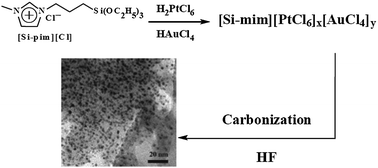a Jiangsu Key Laboratory of Advanced Functional Polymer Design and Application, Department of Polymer Science and Engineering, College of Chemistry, Chemical Engineering and Materials Science, Soochow University, Suzhou, China
b
J. Mater. Chem. A 2013, 1, 9257-9263.
A facile and effective procedure for the synthesis of PtAu nanoparticles–carbon (PtAu–C) via the carbonization of triethoxysilane-derivatized ionic liquids is reported. A triethoxysilyl-functionalized ionic liquid, 1-methyl-3-[3-(triethoxysilyl)propyl]imidazolium chloride ([Si-pim][Cl]) was synthesized and anion-exchanged with a Pt precursor (H2PtCl6) and a Au precursor (HAuCl4) to form [Si-pim][PtCl6]x[AuCl4]y (the suffixes x and y represent the relative molar ratios of Pt and Au in the feed, respectively). The carbonization of [Si-pim][PtCl6]x[AuCl4]y, followed by hydrofluoric acid (HF) etching, produced PtxAuy–C hybrids. The composition of the PtxAuy alloy NPs can be controlled simply by adjusting the feed ratio in the metal precursor solution. The electrocatalytic properties of the prepared PtxAuy–C hybrids were determined by the composition of the alloy NPs. The resultant Pt–C hybrids show high electroactivity towards methanol oxidation in an acidic medium, while Pt4Au1–C shows high activity towards the reduction of 4-nitrophenol. The present study provides a highly efficient approach for the development of high-performance noble metals and their alloy-based catalysts.

链接: //pubs.rsc.org/en/content/articlelanding/2013/TA/c3ta11676j#!divAbstract